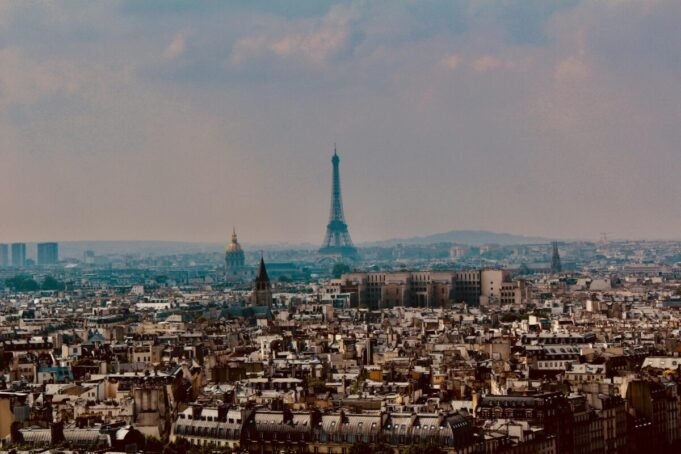The City of Lights once again flickered with the vibrant pulse of creativity and innovation as Paris Fashion Week Fall/Winter 2024 unfolded in all its majestic glory. From towering couture gowns that shimmered under opulent chandeliers to cutting-edge streetwear pulsating with urban energy, the event captivated audiences worldwide, solidifying its position as the preeminent stage showcasing the future of fashion. But beyond the dazzling displays and captivating trends, Paris Fashion Week holds immense significance, not just for the industry itself, but for our cultural landscape as a whole.
A Legacy Woven in Time: A Glimpse into the Parisian Fashion Tapestry
Paris Fashion Week, steeped in a rich history dating back to the 19th century, is more than just a fleeting display of glamorous trends. It’s a meticulously curated platform where the artistry of established maisons like Chanel and Dior intertwines with the audacious visions of fresh talents like Charles de Vilmorin and Kiko Kostadinov. Divided into Haute Couture Week, featuring intricate, one-of-a-kind pieces that push the boundaries of design, and Prêt-à-Porter Week, presenting ready-to-wear collections destined to grace stores and wardrobes globally, the event sets the tone for the upcoming season, influencing everything from the colors we wear to the silhouettes we embrace.
Fall/Winter 2024: A Kaleidoscope of Trends in Motion
This season, the Parisian runways painted a diverse and dynamic picture of what’s to come. Bold colors like emerald green, fiery orange, and cobalt blue, reminiscent of precious gemstones, took center stage, while the sustainability movement emerged as a powerful force, with designers like Stella McCartney and Gabriela Hearst leading the charge. Upcycled materials took on new life in innovative designs, and circular fashion models were championed, reflecting a growing global consciousness about the industry’s environmental impact. Technological innovation also stepped into the spotlight, with brands like Iris van Herpen incorporating 3D-printed elements into their ethereal creations, blurring the lines between reality and the fantastical.
Under the Spotlight: Shows that Ignited the Fashion Sphere
Amidst the myriad presentations, several shows left an indelible mark on the fashion landscape:
- Balenciaga’s Demna Gvasalia masterfully challenged our perceptions of luxury with his unconventional approach. Juxtaposing high-end materials with everyday objects, he transformed garbage bags and parkas into coveted pieces, sparking conversations about fashion’s boundaries and the power of everyday inspiration.
- Giambattista Valli’s romantic vision unfolded in a sea of voluminous tulle gowns, adorned with exquisite floral embellishments. Each piece was a testament to the enduring allure of timeless elegance, reminding us that even in a world obsessed with innovation, there’s still a place for ethereal beauty.
- Marine Serre’s environmentally conscious collection, aptly titled “Amor Fati,” featured upcycled textiles and innovative techniques, challenging us to rethink our relationship with fashion and waste. Her show wasn’t just about aesthetics; it was a powerful call to action, urging the industry to embrace a more sustainable future.
Deeper Dive: Sustainability Takes Center Stage, But is it Just a Trend?
Sustainability was undeniably a major theme at PFW, reflecting a growing global consciousness about the fashion industry’s environmental impact. But is it merely a fleeting trend or a genuine shift towards a more responsible future? Brands like Chloé and Stella McCartney championed eco-friendly materials like organic cotton and recycled fibers, while Gabriela Hearst showcased her commitment to upcycling and responsible sourcing. These efforts go beyond mere tokenism; they signal a movement towards a more circular fashion future, where waste is minimized and resources are valued. While challenges remain, the growing commitment to sustainability at PFW offers a glimmer of hope for a more responsible and ethical industry.
Emerging Gems: The Future of Fashion, Shining Bright
Beyond established names, PFW serves as a launchpad for fresh talent, injecting the industry with much-needed diversity and dynamism. This season, designers like Charles de Vilmorin and Kiko Kostadinov captivated audiences with their unique perspectives and bold aesthetics. De Vilmorin’s whimsical garments blurred the lines between reality and fantasy, while Kostadinov’s deconstructed tailoring offered a contemporary twist on classic silhouettes. These young designers represent the future of fashion, a future that is diverse, inclusive, and unafraid to push boundaries.
Beyond the Runway: A Global Impact that Extends Far and Wide
The influence of Paris Fashion Week extends far beyond the immediate audience. It sets the tone for the upcoming season, dictating trends that trickle down to mainstream retailers and influence consumer choices globally. From the colors we wear to the silhouettes we embrace, PFW shapes the visual landscape of our world. But its impact goes beyond aesthetics. PFW serves as a platform for social commentary, sparking conversations about identity, inclusivity, and the role of fashion in our culture. This season, designers like Simone Rocha and Rick Owens celebrated diverse body shapes and challenged traditional notions of beauty with their unconventional silhouettes and inclusive casting. Additionally, Maria Grazia Chiuri at Dior used her platform to highlight the fight for female empowerment, her show featuring feminist slogans and powerful statements on the runway. These efforts remind us that fashion is not just about clothes; it’s a powerful tool for social change and self-expression.
The Economics of Grandeur: Fashion Week’s Contribution to the City and Industry
Paris Fashion Week is not just a cultural phenomenon; it’s a significant economic driver. The event generates billions of euros annually, boosting the city’s tourism, hospitality, and luxury goods sectors. From hotels and restaurants overflowing with international guests to ateliers buzzing with activity, the ripple effect of PFW is undeniable. Additionally, the event plays a crucial role in launching and sustaining fashion brands, providing a platform for established houses to showcase their latest collections and for emerging talent to gain valuable exposure. This economic impact reinforces the importance of PFW within the global fashion ecosystem.
A Legacy Enduring: Fashion Week’s Role in Shaping the Cultural Narrative
Ultimately, Paris Fashion Week is more than just a fleeting display of trends; it’s a cultural barometer, reflecting the zeitgeist and shaping the conversations that define our era. From the sustainability movement gaining momentum to designers using their platforms for social commentary, PFW serves as a lens through which we can understand the evolving cultural landscape. The event transcends the industry itself, sparking conversations about identity, beauty, and the role of fashion in our lives.
Looking Ahead: What Does the Future Hold?
As the final curtain falls on another season of Paris Fashion Week, the question remains: what does the future hold? While trends may come and go, the core values of creativity, innovation, and self-expression that underpin the event are sure to endure. Whether it’s the rising focus on sustainability, the increasing visibility of diverse voices, or the continuous push for technological advancements, PFW promises to remain at the forefront of shaping the future of fashion, leaving us eagerly anticipating the next chapter in this captivating story.




































